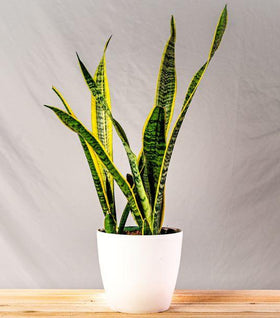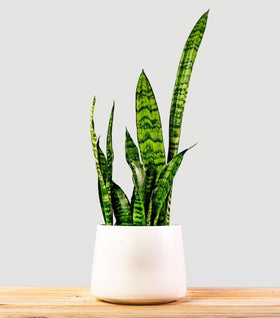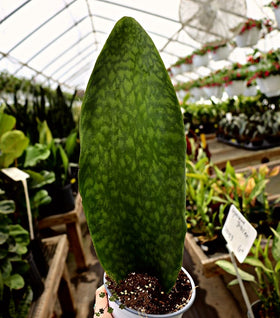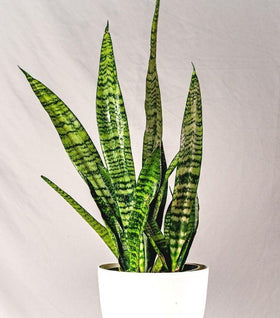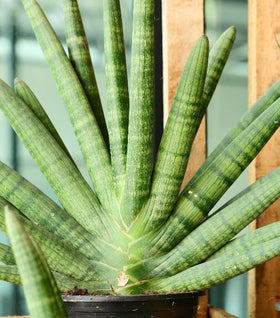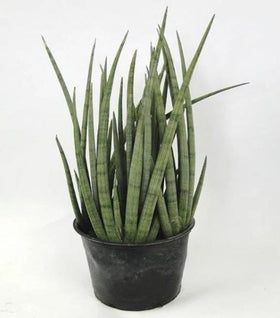Snake Plants for Sale Online
It doesn't get much easier than a snake plant if you're looking for an easy-to-grow house plant. Whether you call it Snakeplant, Sansevieria, Mother-in-laws tongue, or Snake Plant, there are very few indoor plants that are easier to grow. Snake plants are perfect for any home, apartment, or office. They thrive in low-light, including fluorescent lights in windowless offices.
Snake plants are ideal for homes and offices because they are superb Air-purifying Plants. NASA studies have consistently shown that the plant removes toxins from the indoor air, such as formaldehyde, xylene, toluene, and nitrogen oxides. Of all the well-known oxygen-producing plants, Snake plants are unique since they convert a lot of CO2 (carbon dioxide) to O2 (oxygen) at night, making them ideal plants to have in your bedroom.
Types of Snake Plants:
Snake Plants are some of the most popular houseplants today this shouldn't be surprising. There are around 70 different species of snake plant, all native to tropical and subtropical regions of Europe, Africa, and Asia. Snake Plants are almost indestructible and adaptable to many growing conditions and locations.
Snake Plants are considered succulents due to their ability to store water in their leaves. This makes them reasonably immune to neglect. Sansevieria are some of the most low-light tolerant houseplants available, making them the perfect choice for any home or office. Their simple, architectural lines are very much in tune with modern decorating styles, and their upright habit makes them suitable for displaying even in the smallest of spaces.
Snake Plants are divided into three distinct groups or types.
Sansevieria trifasciata
Sansevieria trifasciata are the most widespread and popular of the snake plant family. This type of Snake Plant sansevieria, has long, flat, tongue-shaped leaves that grow in a stiff, upright manner. The leaves are usually mottled or variegated with horizontal bars or stripes of white, golden, or yellow on dark green to pale silvery-green. Examples of this type are the Sansevieria zeylanica, the Sansevieria laurentii or laurentii snake plant, and the trendy black coral.
Bird's Nest
Bird's Nest forms of Snake Plants have dense, rosettes of leaves. They are low-growing and are more compact. The leaf colors are similar to the trifasciata types, and people often use both types in a grouping of pots. This family includes Night Owl Snake Plant and sansevieria Futura superba.
Sansevieria cylindrica
Sansevieria cylindrica or cylindrical snake plants have tall, smooth, spear-shaped green leaves with sharp, pointed tips. They usually have a dark green, striped pattern and are sometimes called the African Spear Plant. The Fernwood Mikado snake plant is an example of this type that is growing in popularity. This group tends to grow wider than their upright cousins, so be aware that these take up more room when they mature.
Specialty Snake Plants
There are a few snake plants that don't fit the typical model of snake plants. One is the Whale Fin Snake Plant. This is by far one of our favorites and is becoming more common. The leaves of this plant can be up to 6 inches white and the mottled colors on the leaves are quite interesting. Another interesting type of snake plant is the Dragon Fingers Snake Plant. This plant is braided into groups of three or more. As this plant grows you will need to continue to braid the leaves.
Choosing the Best Location for your Snake Plant
Snake plants are often touted as low-light plants, but they are actually happiest in bright, indirect light. Yes, they will grow in an office with no natural light but situating them near an eastern or western window brings out the best color and speeds the growth process. Too much direct sunlight tends to bleach out the leaves and they won't be as colorful as plants grown in less light.
Tips for growing Snake Plants
The biggest mistake you can make with your snake plant is to overwater it. Overwatering can cause the roots to rot. Since they are succulent plants they are drought tolerant. If you are a notorious underwater then snake plants will be perfect for you. Water your snake plants about once a month in the fall and winter, and perhaps twice per month in the summer and spring.
Snake Plants are perfect for the office. If you take a week's vacation there's no need to ask anyone to water your plants.
Why are the leaves of my Snake Plant wrinkling?
When the leaves of your Snake Plant this could mean one of two things and you'll need to do some investigating to pinpoint the exact cause.
If you see the leaves start to wrinkle or dry out a little and you keep it on a light watering schedule, all you have to do is water it a bit more often.
Sometimes when you see wrinkles in the leaves, it could be a signal that the snake plant has root rot. This means the plant has been overwatered to the point that the roots have been damaged. This is tougher to fix. Other signs of root rot to look for include soft and mushy leaves.
Healthy snake plant leaves are rigid or stiff. If you believe you've overwatered your plant, immediately stop watering, allow the plant to dry out, and consider removing the soil and repotting it with fresh soil.
Are Snake Plants Pet Safe?
Snake Plants are not considered pet safe so if you own a pet, you should be careful where you place your snake plant. The leaves can be irritating to a pet's mouth if eaten and can lead to digestive issues. Placing them low to the ground might not be the best idea for your furry friends. However many people own pets that are not interested in house plants and can coexist safely with your plants.

